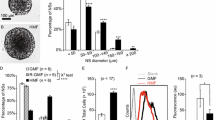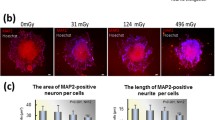Abstract
Objectives
Epidemiological studies have suggested that exposure to environmental and occupational electromagnetic fields (EMFs) contribute to the induction of brain tumors, leukemia, and other neoplasms. The aim of this study was to investigate the genotoxic effects of exposure to 50-Hz EMFs. and of co-exposure to cisplatin, a mutagen and carcinogen, and 50-Hz EMFs, using an in vivo newborn rat astrocyte micronucleus assay.
Methods
Three day-old male Sprague-Dawley rats were co-exposed to 50-Hz EMFs and 1.25 or 2.5 mg/kg of cisplatin. Brain cells were dissociated into single cells and cultured for 96 hours, then stained with acridine orange and an antibody against glial fibrillary acidic protein. The frequency of micronucleated astrocytes was counted with a fluorescent microscope.
Results
The frequency of micronuclei was not increased in rat astrocytes exposed to EMFs alone. However, the frequencies of micronuclei in co-exposure to 2.5 mg/kg cisplatin and EMFs (7.5- and 10-mT) were significantly increased, compared with those in exposure to 2.5 mg/kg cisplatin alone (sham-exposure, 0-mT EMFs) for 72 hours (p<0.01).
Conclusion
Exposure to EMFs alone did not have a genotoxic effect but co-exposure to EMFs increased the genotoxic activity induced by cisplatin. Our findings suggest that EMFs enhance the genotoxic effects of cisplatin.
Similar content being viewed by others
References
Miller RD, Neuberger JS, Gerald KB. Brain cancer and leukemia and exposure to power-frequency (50- to 60-Hz) electric and magnetic fields. Epedemiol Rev. 1997; 19: 273–293.
Kheifets LI. Electric and magnetic field exposure and brain cancer: a review. Bioelectromagnetics. 2001; Sup 5: S120-S131.
McCann J, Dietrich F, Raffery C, Martin A. A critical review of the genotoxic potential of electric and magnetic fields. Mutat Res. 1993; 297: 61–95.
McCann J, Dietrich F, Raffery C. The genotoxic potential of electric and magnetic fields: an update. Mutat Res. 1998; 411: 45–86.
Heddle LA, Hite M, Kierkhart B, Mavourin K, MacGregor JT, Newell GW, Salamone MF. The induction of micronuclei as a measure of genotoxicity, A report of the US Environmental Protection Agency Gene-Tox Program. Mutat Res. 1983; 123: 61–118.
Toga W, Suzuki Y, Shimizu H. In vivo micronuclei test in rat newborn astrocytes. 8th International Conference on Environmental Mutagens. Shizuoka, October, 2001. Mutat Res. 2001; 483 (Suppl. 1): S162.
Miyakoshi Y, Suzuki Y, Ooida M, Takahashi A, Tsukui M. Micronucleus test using cultured new born rat astrocytes. Ind Health. 1999; 37: 95–102.
Suzuki Y, Shimizu H, Kim SU. Induction of micronucleus in NSC19 motoneuron cell line by genotoxic chemicals. Neuro Toxicol. 1997; 18: 325–330.
Kastenbaum MA, Bowman KO. Tables for determining the statistical significance of mutation frequencies. Mutat Res. 1970; 9: 527–549.
Loscher W, Mevissen M, Lehmacher W, Stamm A. Tumor promotion in a breast cancer model by exposure to a weak alternating magnetic field. Cancer Lett. 1993; 71: 75–81.
Thun-Battersby S, Mevissen M, Loscher W. Exposure of Sprague-Dawley rats to a 50-Hertz, 100-μTesla magnetic field for 27 weeks facilitates mammary tumorgenesis in the 7, 12-dimethylbenz (a) anthracene model of breast cancer. Cancer Res. 1999; 59: 3627–3633.
Mevissen M, Kietzmann M, Loscher W.In vivo exposure of rats to a weak alterinating magnetic field increases ornithine decarboxylase activity in the mammary gland by a similar extent as the carcinogen DMBA. Cancer Lett. 1995; 90: 207–214.
Wei M, Guizzetti M, Yost M, Costa LG. Exposure to 60-Hz magnetic fields and proliferation of human astrocytoma cellsin vitro. Toxicol Appl Pharmacol. 2000; 162: 166–176.
Ooida M, Miyakoshi Y, Tsukui M, Liu D, Asanuma K, Suzuki Y.In vitro micronucleus test for six chemicals using cultured rat astrocytes. Environmental Sciences. 2000; 7: 57–69.
Sakaba H, Liu D, Tukui M, Asnuma K, Takahashi A, Suzuki Y. Micronucleus test with a metabolic activation system and cultured astrocytes. Jikeikai Med J. 2000; 47: 131–138.
Rozenxweig M, von Hoff DD, Slavik M, Muggia FM.Cis-diamminedichloroplatinum (II) a new aniticancer drug. Ann Intern Med. 1977; 86: 803–812.
Loehrer PJ. Diagnosis and treatment, drugs five years later. Ann Intern Med. 1984; 100: 704–713.
Benedict WF, Baker RL, Haroun L, Choi E, Ames BN, Mutagenicity and cancer chemotherapeutic agents in the Salmonell-microsome test. Cancer Res. 1977; 37: 2209–2213.
Rosenberg B. Fundamental studies with cisplatin. Cancer. 1985; 55: 2303–2316.
Beck DJ, Brubaker RR. Mutagenicity properties of cisplatinum (II) diamminedichloride in E. coli. Mutat Res. 1975; 66: 181–189.
Turnbull D, Popescu NC, DiPaolo JA, Mythr BC. cis-Platinum (II) diammine dichloride causes mutation, transformation and sister-chromatid exchanges in cultured mammalian cells. Mutat Res. 1979; 66: 267–275.
Pleskova I, Blasko M, Siracky J. Chromosomal aberrations, sister chromatid exchange (SCEs) and micronuclei induction with three platinum compounds (cis-DDP, CHIP, CBDCA) in V79 cells in vitro. Neoplasma. 1984; 31: 655–659.
Adey WR. Biological effects of electromagnetic fields. J Cell Biochem. 1993; 51: 410–416.
Frey AH. Electromagnetic field interactions with biological systems. FASEB J. 1993; 7: 272–281.
Koifman S. Electromagnetic fields—a cancer promoter? Med Hypotheses. 1993; 41: 23–27.
Loscher W, Mevissen M. Animal studies on the role of 50/60 Hertz magnetic fields in carcinogenesis. Life Sci. 1994; 54: 1531–1543.
Reiter RJ. Static and extremely low frequency electromagnetic field exposure—reported effects on the circardian production of melatonin. J Cell Biochem. 1993; 51: 394–403.
Walleczek J. Electromagnetic field effects on cells of the immune system: the role of calcium signalin. FASEB J. 1992; 6: 3177–3185.
Repacholi MH, Greenbaum B. Interaction of static and extremely low frequency electric and magnetic fields with living systems: health effects and research needs. Bioelectromagnetics. 1999; 20: 133–160.
Schernhammer ES, Schulmeister K. Melatonin and cancer risk: does light at night compromise physiologic cancer protection by lowering serum melatonin levels? Br J Cancer. 2004; 90: 941–943.
Stevens RG, Davis S, Thomas DB, Anderson LE, Wilson BW. Electric power, pineal function, and the risk of breast cancer. FASEB J. 1992; 6: 853–860.
Karasek M, Lerchl A. Melatonin and magnetic fields. Neuroendocrinol Lett. 2002; 23 (Suppl 1): 84–87.
Loscher W, Liburdy RP. Animal and cellular studies on carcinogenesis effects of low frequency (50/60-Hz) magnetic fields. Mutat Res. 1998; 410: 185–220.
Phillip JL. Effects of electromagnetic field exposure on gene transcription. J Cell Biochem. 1993; 51: 381–386.
Lin H, Bland M, Rossol-Haseroth K, Goodman R. Regulating genes with electromagnetic response elements. J Cell Biochem. 2001; 81: 143–148.
Marcu KB, Bossome SA, Patel AJ. MYC function and regulation. Annu Rev Biochem. 1992; 61: 809–860.
Tofani S, Barone M, Berardelli M, et al. Static and ELF magnetic fields enhance the in vivo anti-tumor efficacy of cis-platin against lewis lung carcinoma. But not of cyclophosphamide against B16 melanotic melanoma. Pharmacol Res. 2003; 48: 83–90.
Shimizu H, Akiyama M, Suzuki Y, Hayashi K. The effects of magnetic field on mutagenic activity. Mutat Res. 1989; 16: 377.
Okonogi H, Nakagawa M, Tsuji Y. The effects of a 4.7 tesla static magnetic field on the frequency of micronucleated cells induced by mitomycin C. Tohoku J Exp Med. 1996; 180: 209–215.
Tsuji Y, Nakagawa M, Suzuki Y. Five-tesla static magnetic fields suppress food and water consumption and weight gain in mice. Ind Health. 1996; 34: 347–357.
Satoh M, Tsuji Y, Watanabe Y, Okonogi H, Suzuki Y, Nakagawa M, Shimizu H. Metallothionein content increased in the liver of mice exposed to magnetic fields. Arch Toxicol. 1996; 70: 315–318.
Watanabe Y, Nakagawa M, Miyakoshi Y. Enhancement of lipid peroxidation in the liver mice exposed to magnetic fields. Ind Health. 1997; 35: 285–290.
Suzuki Y, Ikehata M, Nakamura K, Nishioka M, Asanuma K, Koana T, Shimizu H. Induction of micronuclei in mice exposed to static magnetic fields. Mutagenesis. 2001; 16: 499–501.
World Health Organization International Agency for Research on Cancer. IARC monographs on the evaluation of carcinogenic risks to humans, volume 80, Non-ionizing radiation, part 1: static and extremely low-frequency (ELF) electric and magnetic fields. Lyon France; IARC Press; 2002. p. 331–338.
World Health Organization International Agency for Research on Cancer. IARC monographs on the evaluation of carcinogenic risks to humans, volume 80, Non-ionizing radiation, part I: static and extremely low-frequency (ELF) electric and magnetic fields. Lyon France: IARC Press; 2002. p. 51–66.
Author information
Authors and Affiliations
Corresponding author
Rights and permissions
About this article
Cite this article
Miyakoshi, Y., Yoshioka, H., Toyama, Y. et al. The frequencies of micronuclei induced by cisplatin in newborn rat astrocytes are increased by 50-Hz, 7.5- and 10-mT electromagnetic fields. Environ Health Prev Med 10, 138–143 (2005). https://doi.org/10.1007/BF02900806
Received:
Accepted:
Issue Date:
DOI: https://doi.org/10.1007/BF02900806




